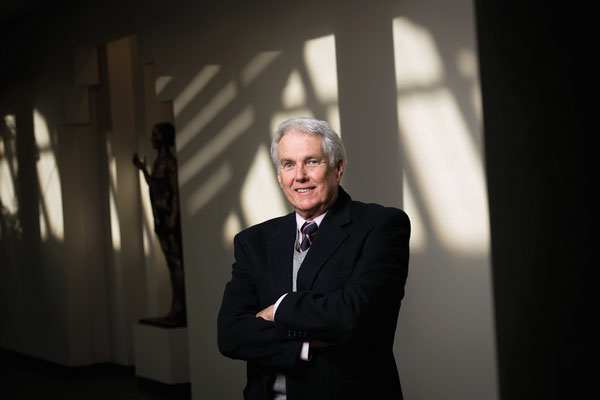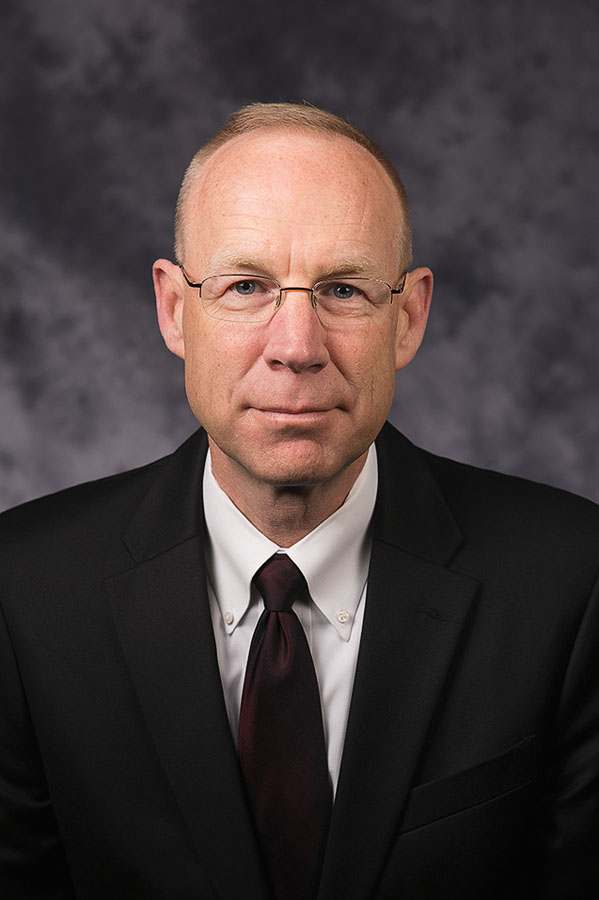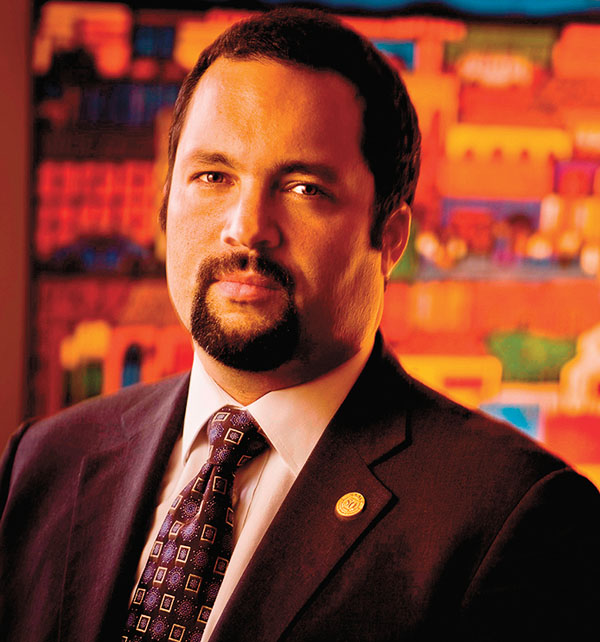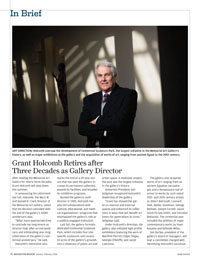In Review
 ART DIRECTION: Holcomb oversaw the development of Centennial Sculpture Park, the largest initiative in the Memorial Art Gallery’s history, as well as major exhibitions at the gallery and the acquisition of works of art ranging from ancient Egypt to the 20th century. (Photo: Adam Fenster)
ART DIRECTION: Holcomb oversaw the development of Centennial Sculpture Park, the largest initiative in the Memorial Art Gallery’s history, as well as major exhibitions at the gallery and the acquisition of works of art ranging from ancient Egypt to the 20th century. (Photo: Adam Fenster)After leading the Memorial Art Gallery for nearly three decades, Grant Holcomb will step down this summer.
In announcing his retirement last fall, Holcomb, the Mary W. and Donald R. Clark Director of the Memorial Art Gallery, noted that his decision coincided with the end of the gallery’s 100th anniversary year.
“What more appropriate time to conclude my long tenure as director than after an extraordinary and exhilarating year-long celebration of the gallery’s centennial anniversary,” he said.
Holcomb’s retirement also marks the end of a 29-year tenure that has seen the gallery increase its permanent collection, expand its facilities, and broaden its exhibition programs.
Named the gallery’s sixth director in 1985, Holcomb has also led collaborations with cultural, educational, and medical organizations—programs that emphasized the gallery’s role as a publicly engaged institution.
Last fall, the gallery formally dedicated Centennial Sculpture Park, which includes four site-specific sculptures and recasts 10 acres of the gallery’s grounds into a showcase of public art and urban space. A multiyear project, the park was the largest initiative in the gallery’s history.
University President Joel Seligman recognized Holcomb’s leadership of the gallery.
“Grant has shaped the gallery’s internal and external spaces and enhanced its collections in ways that will benefit art lovers for generations to come,” Seligman said.
Under Holcomb’s direction, the gallery also initiated high-profile exhibitions featuring the work of Maxfield Parrish, Edgar Degas, Georgia O’Keeffe, and Jacob Lawrence. The gallery also acquired works of art ranging from an ancient Egyptian sarcophagus and a Renaissance suit of armor to works by such noted 19th- and 20th-century artists as Albert Bierstadt, Leonard Volk, Walter Goodman, George Bellows, Joseph Cornell, Jaune Quick-To-See Smith, and Christian Boltanski. The centennial year included the addition of major contemporary works by Yayoi Kusama and Kehinde Wiley.
Jim Durfee, president of the gallery’s board of managers, will lead a committee charged with identifying Holcomb’s successor.
New Public Safety Director Named
 PUBLIC SAFETY: Fischer will lead the University’s Department of Public Safety. (Photo: Adam Fenster)
PUBLIC SAFETY: Fischer will lead the University’s Department of Public Safety. (Photo: Adam Fenster)A former trooper, investigator, and administrator with the New York State Police who has spent the past two years serving as deputy director of the University’s Department of Public Safety, has been named to lead the department. Mark Fischer, who joined the department in 2011 as part of a leadership succession plan, became director in December.
He succeeds Walter Mauldin, who will become a senior advisor, focusing on assessment, policy, and planning for the department. Mauldin joined the University in 1980 as director of what was then known as security services.
Ron Paprocki, senior vice president for administration and finance and chief financial officer of the University, saluted Mauldin for his long tenure in working to ensure the safety of students, faculty, and staff.
“Walter has provided nearly 34 years of key leadership to the department that serves our most critical function—the safety of our University community members,” said Paprocki. “He has created a department that is well respected by our community and by our local law enforcement agencies. Most recently, his leadership in the multiyear effort to establish the University’s first sworn officer program has resulted in a stronger and coordinated response structure within public safety.”
Fischer becomes chief of a 134-member force that includes 27 newly active sworn peace officers and another group of 25 currently in training.
Nursing Earns Accreditation
The School of Nursing has earned full, 10-year accreditation for all of its baccalaureate and master’s degree programs, as well as its doctor of nursing practice program, the Commission on Collegiate Nursing Education reported last fall. The commission conducted a three-day, onsite evaluation of the school last March.
The commission evaluates the quality and integrity of baccalaureate, graduate, and residency programs in nursing, according to nationally recognized standards. The accreditation process is designed to hold nursing programs accountable to the profession, consumers, employers, higher education, and students and their families by measuring each academic program’s success at achieving its mission, goals, and expected outcomes. The process helps ensure that nursing graduates are prepared for their professional roles and fosters continuing improvement in nursing programs.
“This is a true testimony to the hard work and investment put forth by our entire school, our faculty, staff, and our students,” said Kathy Rideout ’95W (EdD), dean of the school.
Mellon Grant Focuses on Humanities and Technology
Doctoral students in the humanities will have new support to study and to learn to use new technology.
That’s after the Andrew W. Mellon Foundation awarded the University a $1 million grant to support a graduate program designed by Rochester faculty to train humanities students to integrate digital technologies into innovative research programs.
The award is one of a series of grants the foundation has made in recent years to equip faculty and students at colleges and universities with tools and protocols in the digital humanities.
Students from any of Rochester’s four humanities PhD programs—English, history, philosophy, and visual and cultural studies—are eligible for the fellowship. Fellows will study the theory and practice of digital humanities as a way to discover new avenues of inquiry within their own fields and to serve as apprentices and mentors to communities of undergraduates and faculty members who are collaborating on research projects.
The grant is the latest in a series of initiatives in the digital humanities at Rochester. In addition to hiring faculty in fields related to digital media, the University last fall opened Ronald Rettner Hall for Media Arts and Innovation, a space designed to facilitate multidisciplinary collaboration through technology.
Civil Rights Leader to Give MLK Talk
 GUEST: The youngest person to lead the NAACP, Jealous is set to give the 2014 MLK address. (Photo: NAACP)
GUEST: The youngest person to lead the NAACP, Jealous is set to give the 2014 MLK address. (Photo: NAACP)Benjamin Todd Jealous, the youngest person ever appointed president and CEO of the National Association for the Advancement of Colored People, is scheduled to deliver the University’s Martin Luther King Jr. Commemorative Address in January.
A former community organizer and newspaper editor, Jealous was 35 years old when he was named president of the NAACP in 2008. He announced last fall that he planned to step down from the leadership position at the end of 2013.
A fifth-generation member of the NAACP, Jealous began his career in civil rights at age 18, opening mail at the organization’s Legal Defense Fund.
He has since become an outspoken leader of successful state and local movements to ban the death penalty, outlaw racial profiling, defend voting rights, secure marriage equality, and free wrongfully incarcerated people. A Rhodes Scholar, Jealous is a graduate of Columbia and Oxford universities.
The January 24 talk begins at 6 p.m. in Strong Auditorium.

